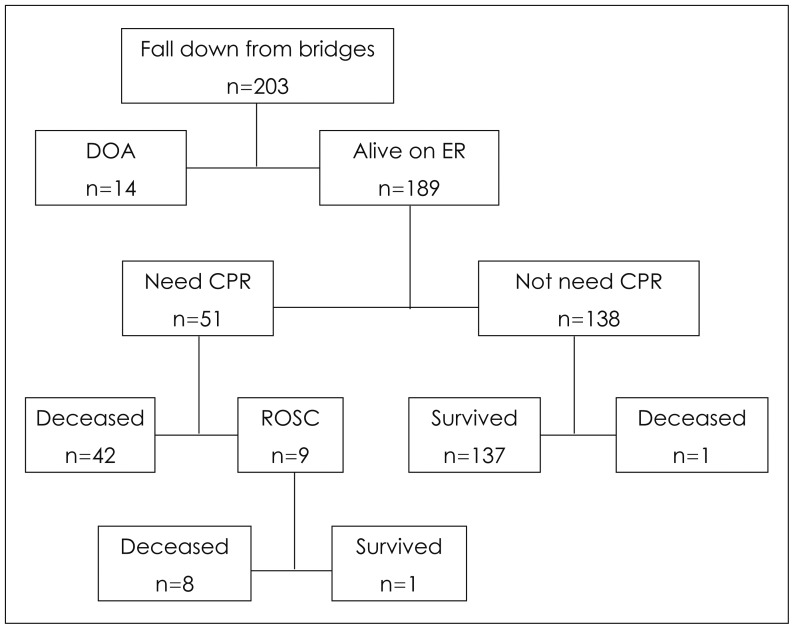Korean J Neurotrauma.
2017 Oct;13(2):85-89. 10.13004/kjnt.2017.13.2.85.
Trauma Patterns of Drowning after Falling from Bridges over Han River
- Affiliations
-
- 1Department of Neurosurgery, Pusan National University Hospital, Busan, Korea. cmcspinehwan@catholic.ac.kr
- 2Department of Neurosurgery, Yeouido St. Mary's Hospital, The Catholic University College of Medicine, Seoul, Korea.
- KMID: 2394539
- DOI: http://doi.org/10.13004/kjnt.2017.13.2.85
Abstract
OBJECTIVE
Recently, the number of patients who fell or jumped from bridges over Han River has rapidly increased. However, the injury patterns and outcomes of these patients have been poorly characterized. The aim of this study was to determine the injury characteristics of these patients.
METHODS
We reviewed the medical records of all patients who were transferred to the Emergency Room due to jumping or falling from bridges over Han River between 2011 and 2015.
RESULTS
A total of 203 patients were included. Among them, 14 (6.9%) patients were dead on arrival, 51 (25.1%) patients were expired in the hospital, and 138 (70%) patients were discharged alive, including a patient who had severe neurologic sequelae after resuscitation. Skeletal and internal organ injuries were identified based on radiologic images. The most injured organ was thorax (58.1%), followed by spine (23.1%), abdomen (11.1%), extremity (7.7%), and cranium (5.2%). Chest tubing for pneumothorax or hemothorax was performed in four (2.9%) patients. Surgical intervention was needed for four patients (2.9%).
CONCLUSION
Trauma patterns were concentrating on the thorax and spine regions. Therefore, complete radiographic evaluation should be performed for these patients.
MeSH Terms
Figure
Reference
-
1. Abel SM, Ramsey S. Patterns of skeletal trauma in suicidal bridge jumpers: a retrospective study from the southeastern United States. Forensic Sci Int. 2013; 231:399.e1–399.e5. PMID: 23806345.
Article2. Brice JH, Moss C, Purpura P, Delbridge TR. Epidemiology of low-level bridge jumping in Pittsburgh: a 10-year study. Prehosp Emerg Care. 2013; 17:155–161. PMID: 23148589.
Article3. Heming N, Serve E, Weiss N, Imbert A, Ducharne G, Diehl JL, et al. Drowning after falling from a medium-height bridge: multiple trauma victims. Prehosp Emerg Care. 2012; 16:356–360. PMID: 22494150.
Article4. Lukas GM, Hutton JE Jr, Lim RC, Mathewson C. Injuries sustained from high velocity impact with water: an experience from the Golden Gate Bridge. J Trauma. 1981; 21:612–618. PMID: 7265332.5. Palmer CS, Gabbe BJ, Cameron PA. Defining major trauma using the 2008 Abbreviated Injury Scale. Injury. 2016; 47:109–115. PMID: 26283084.
Article6. Simonsen J. Injuries sustained from high-velocity impact with water after jumps from high bridges. A preliminary report of 10 cases. Am J Forensic Med Pathol. 1983; 4:139–142. PMID: 6858999.7. Snyder RG, Snow CC. Fatal injuries resulting from extreme water impact. Aerosp Med. 1967; 38:779–783. PMID: 6049234.8. Vaccaro AR, Koerner JD, Radcliff KE, Oner FC, Reinhold M, Schnake KJ, et al. AOSpine subaxial cervical spine injury classification system. Eur Spine J. 2016; 25:2173–2184. PMID: 25716661.
Article9. Vaccaro AR, Oner C, Kepler CK, Dvorak M, Schnake K, Bellabarba C, et al. AOSpine thoracolumbar spine injury classification system: fracture description, neurological status, and key modifiers. Spine (Phila Pa 1976). 2013; 38:2028–2037. PMID: 23970107.
- Full Text Links
- Actions
-
Cited
- CITED
-
- Close
- Share
- Similar articles
-
- Seasonal variation of water qualities in the upper and middle reaches of the Han River(1998.8~1989.9)
- Establishment of Diatom Profile for Improving Reliability of Diagnosis of Drowning - Centered on the Main Drowning Sites of Han River
- Drowning-Related Injuries: Fallen from the Bridge for the Purpose of Suicide
- A Simulation of the Oxygen Profile in the Han River
- Near-Drowning


